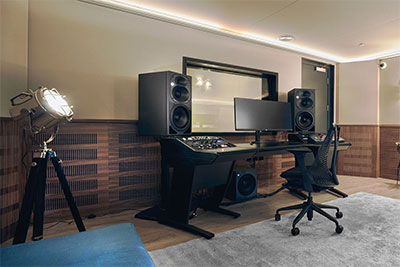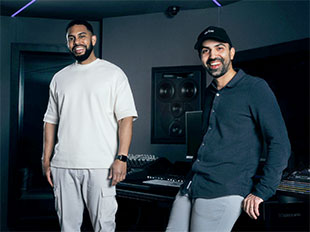![]() With the studio they were using less than ideal, comparing notes between sessions in a cramped kitchen prompted Amin Hamzianpour and Nicholas Sonuga to come up with the concept of Qube – a purpose-built space available to rent to musicians, and also podcasters, YouTubers, artists and photographers.
With the studio they were using less than ideal, comparing notes between sessions in a cramped kitchen prompted Amin Hamzianpour and Nicholas Sonuga to come up with the concept of Qube – a purpose-built space available to rent to musicians, and also podcasters, YouTubers, artists and photographers.
A London location where members would work and socialise in the same building seemed a good place to start...
While not new, Hamzianpour and Sonuga wanted to develop the concept of studios hiring rooms to producers and musicians to address issues such as rental costs that are often prohibitive for a space that might be empty for much of the time and the cost of recording equipment being difficult to manage when technology evolves very quickly.
A site in West London was chosen for the first Qube site – now called Qube West. Members enjoyed a discount on room hire but anybody could book a room for as little as half a day and use the on-site facilities – and all related business are also encouraged to come in. The venture proved wildly popular, and thoughts turned to East London’s transformation into a desirable residential area with a large creative community. Local stakeholders were receptive to the idea, and Qube East fitted neatly into their plans.
 The experience of Qube West and the changing market allowed more ambitious thinking to go into Qube East – notably, a Dolby Atmos mixing facility that would address the rapid growth of immersive audio platforms. The equipping of such a room is not for the faint-hearted so expertise from Emerging was sought, since a Trinnov system had previously been installed in the Qube West studio and had been very successful.
The experience of Qube West and the changing market allowed more ambitious thinking to go into Qube East – notably, a Dolby Atmos mixing facility that would address the rapid growth of immersive audio platforms. The equipping of such a room is not for the faint-hearted so expertise from Emerging was sought, since a Trinnov system had previously been installed in the Qube West studio and had been very successful.
‘The vision for Qube has always been to offer flexible, premium studios across a number of easily accessible sites, and Qube East is the first in the expansion rollout,’ Sonuga says of the new venue. ‘We worked with the landowners of Canary Wharf to play a key role in helping to change the identity of the new neighbouring development, Wood Wharf. Its intention is to be a stark contrast to the financial district, a creative district full of fresh bars, restaurants and creative businesses.
‘East is the epicentre of London’s creative community, and, although we’ve only been open a few months, we’ve seen a massive demand from new members waiting for us to open on their doorstep,’ he continues. ‘We based the fundamentals on West but bringing the tech more in line with the premium feel of the building. You’ll find Neumann and PMC in every room, and innovative new studio offerings ranging from fully automated video streaming rooms for DJs and podcasters, through to postproduction edit suites. We’d like Qube to be a home for all content creators across various disciplines, so this really is our first step in diversifying our offering to cater for a wider audience.’
Hamzianpour and Sonuga worked with Sustainable Acoustics and Acoustics GRG on the design and build of the complex, with heavy input from their own team. The Dolby Atmos studio might seem a bold inclusion in Qube East, but they were keen to cater for those who may not have the means to install their own set-up.
‘At Qube, we’re all about carving out affordable and flexible access to creative professionals at all levels,’ Sonuga says. ‘Until now, if you wanted an Atmos mix, you’d need to book an expensive room at one of the established studios, whereas Qube offers an alternative, booking by the hour. This allows our members and clients to mix in Atmos without the budget constraints or time limitations. East London has the largest demographic of music creators in the UK, so we were sure that the rise of Dolby Atmos for music would allow us to cater for them.
‘It sounds incredible,’ he adds. ‘It’s certainly the best sounding room in the building. The immersive audio is unreal, it really allows you to place yourself within the audio field and experience the music to its full potential.’
Sonuga says that the most important elements for the Atmos room were clean conversion and neutral monitoring. They narrowed the choices down to Merging and Avid for the conversion, and Neumann and PMC for monitoring...
 ‘We were steered towards Merging for their reputation as well as their helpful demo service, we were blown away with the transparency of the conversion along with the handy integration of the Anubis/Hapi control system which gave us the functionality we needed in a rack and desktop format,’ he recalls. ‘An important feature was being able to easily switch between stereo and Atmos mixes, as well as simplified plug and play options for clients bringing in their own rigs. The Merging rig gave us everything we were looking for in a tech spec.
‘We were steered towards Merging for their reputation as well as their helpful demo service, we were blown away with the transparency of the conversion along with the handy integration of the Anubis/Hapi control system which gave us the functionality we needed in a rack and desktop format,’ he recalls. ‘An important feature was being able to easily switch between stereo and Atmos mixes, as well as simplified plug and play options for clients bringing in their own rigs. The Merging rig gave us everything we were looking for in a tech spec.
‘I consider Neumann speakers to sit at the top of the market, while delivering serious bang for buck,’ he says, moving on to monitoring. ‘We did shootouts against PMC and Focal, and the Neumanns just sounded the best as well as being priced competitively. The sound isn’t too clinical, so doesn’t suck the life out of music. The 310 three-way drivers offer excellent depth and spatial fields which I haven’t heard in any other speakers in the same price bracket – truly impressive engineering.’
A key role in the project fell to Paul Mortimer’s team at equiment supplier, Emerging.
‘We first met Paul when purchasing a Trinnov ST2 Pro system for our West London site,’ Sonuga says. ‘He was always on hand and super helpful, so was a natural choice when considering suppliers. Ben Andrews was also extremely generous with his time and technical knowledge, and visited us to provide a comprehensive demo as well as being available for support during the tech install stage.’
‘Working with Ben has been a pleasure,’ adds Qube General Manager, Byron Carmona. ‘Since day one he was very helpful and showed us the capabilities of the Merging rig: from the high quality conversion to the expandability of the gear we have.’
For Qube East, Emerging supplied the Merging Atmos system, which comprises a Hapi Mk2 and an Anubis. These are networked so we can control all the monitoring from the Anubis and the two units combined give us sufficient outputs for 7.1.4. It is such a great sounding system and ticks all the boxes for easy control of the monitoring.
‘It’s still early days as we haven’t yet officially opened the room for bookings, but features such as the integration of Sound ID Reference from Sonarworks allowed us to tune the room acoustics to sound phenomenal, complementing the acoustic treatment nicely. The Atmos rig is intuitive to use; even our community staff and assistant engineers can fire it up without tons of technical experience. Ease of use is super important. We have many different people in and out of the studios, so we like to make things as streamlined as possible to avoid complexities.
‘One of the main goals was that we required a set-up that could be used both on our house rig and as a plug-and-play – for any engineers bringing their own machine – and Ben was able to showcase this from the beginning and answer any questions we had.
‘The feedback that we have had from our engineers regarding the quality of the Merging rig, combined with the Neumann monitoring system, has been incredible. We have seen very big smiles in the studio every time we fire up a reference track. The Anubis is the star of the show each time – the ability to reference from 7.1.4 to a 2.1 folded-down mix with the press of a button is a godsend.’